Dashboard Modeling
Best practices and examples for creating dashboards tailored to various use cases.
Overview
Dashboards are and should be one of the main concerns of customers when creating their workspace or when tackling a use case, because dashboards can provide great value to the user base.
A dashboard is a functionality in SAP LeanIX which allows customers access to new, pending actions and information. It is also acting as an enabler of more efficient processes and as a tool for fast decision making. It is used to organize the data stored in the workspace into actionable insights.
Dashboards can be understood as the headline of newspaper articles. The content of these articles comes directly from the inventory and the reports in SAP LeanIX.
In the end of the day it is a collaboration feature to create ways of sharing data and showcase why certain decisions should be made. Dashboards provide great value when relating them directly to company strategy.
Main three uses of dashboards:
- Stakeholder Management/ Team Dashboards/ Persona Dashboard (e.g. CIO, Project Team)
- Call to actions with regards to use cases (e.g. What is the status of our cloud migration? Where is a review of data for this use case necessary?)
- Deliverables (define strategies and objectives to display on dashboard)
Note
The dashboards described here are examples and best practices from customers of different sizes and largely independent of the industry.
If you are interested in creating one of the following described dashboards, please align with your CSM to tailor the example/ best practice to your needs.
Stakeholder Management, Team Dashboards, and Persona Dashboard
Important features:
- Welcome message to address stakeholders directly
Welcome them to the workspace, explain to them what they see on the dashboard, eventually what is required of them or what they are asked to do, and if applicable links to further resources, training material and so on. - Find reports and Fact Sheet charts that answer the stakeholders key questions,
eg. a CIO might ask:- How do I increase revenue?
- How do I reduce cost?
- How do I manage risk?
- Use filtered and saved reports as well as Fact Sheet charts that show the overall health of the EA program
- Include a To Do Panel, so users are being led directly to their open tasks
Example: Project Dashboard
- Welcome message with an introduction to projects and this dashboard, including important links
- Project portfolio report to display project risk and business value
- Roadmap reports on companies' projects
- Fact Sheet chart to display projects to keep
- Fact Sheet chart on strategic importance of projects
Requirements
In this example the Fact Sheet chart is making use of the Tag Group “Projects to keep” with 2 Tags (Large benefit, marginal benefit) and the Tag Group "Group Technology Strategy Objectives" with 3 Tags (Company Project, Foundational Project, Group Project).
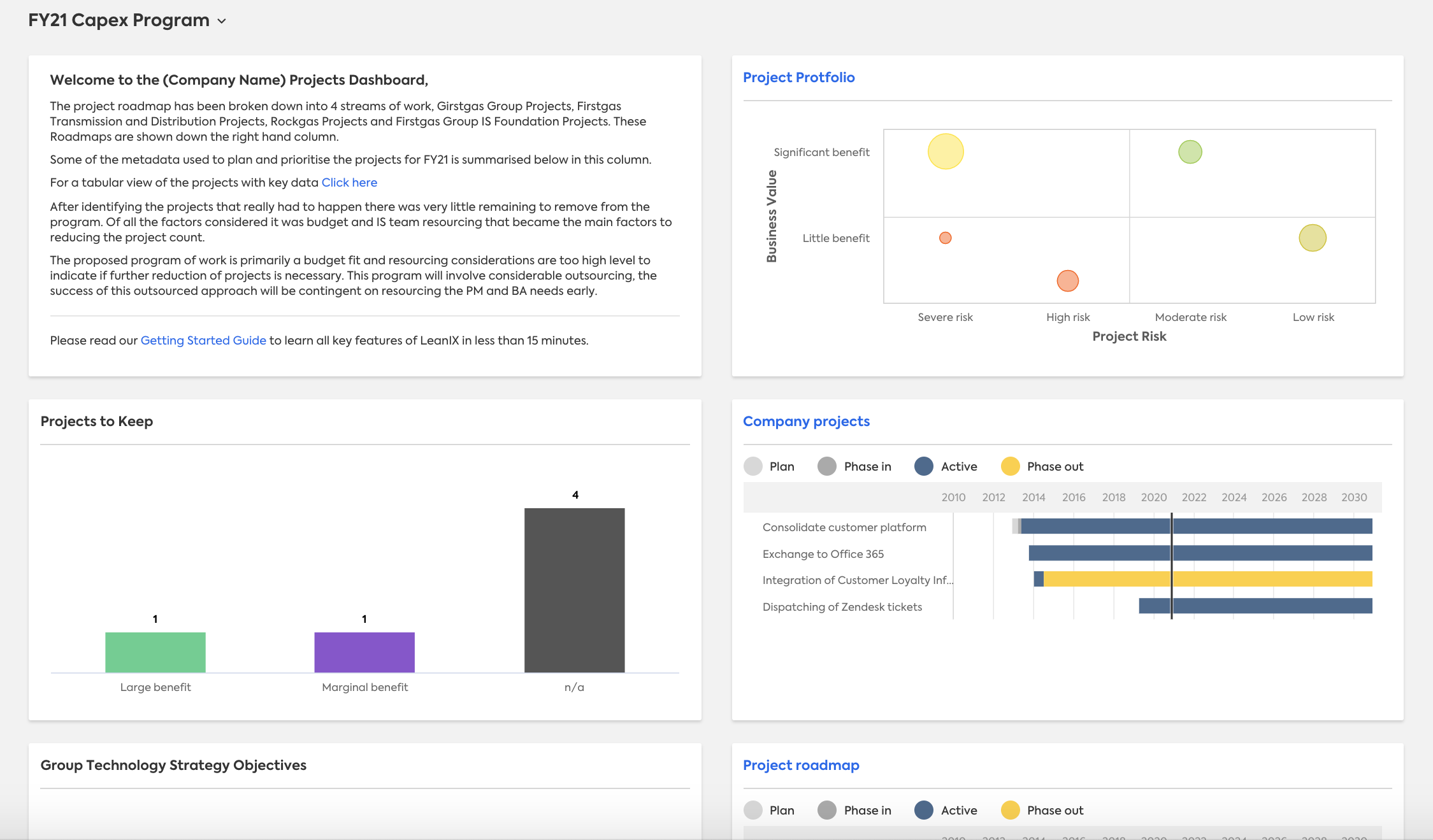
Call-to-Action with Regards to Use Cases
Important features:
- Welcome message to introduce the use case, clarify the use case approach and eventually actions you are asking for from users
- Include a To Do Panel, so users are being led directly to their open tasks
- Find Fact Sheet charts that answer the key questions/ address the key goals of the use case, eg.
- Save 20% of Application cost by Rationalization
- Reduce Technology Risk
- Show use case specific filtered and saved reports
- You might also want to include Metrics if applicable to show use cases development over time
Example: Data Completeness and Inventory Metrics
- Fact Sheet chart to show distribution of Tag Group "FormalCorrectness"
- IT Components with missing information (filtered report for “na”)
- Metrics: Number of Applications
- Metrics: Number of IT Components
Requirements
In this example the Fact Sheet chart is making use of the Tag Group “FormalCorrectness” with 4 Tags (Completed, New and not yet completed, Not yet completed, Not relevant).

Example: Application Rationalization
- Fact Sheet chart to show the distribution of Tag Group "TIME Model"
- Application TIME assessment in Application Portfolio report
- Application Roadmap
Requirements
In this example the Fact Sheet chart is making use of the Tag Group “TIME Model” with 4 Tags (Tolerate, Invest, Migrate, Eliminate).

Example: Technology Risk Management
- Application Landscape clustered by TIME Model with technology risk view to see if the TIME assessment adequately addresses your risks
- IT Component Landscape with providers criticality/ quality
- IT Component Landscape with Tech Category Resource Classification
- IT Component Landscape with technical fit view
- IT Component Matrix with lifecycle information
- Provider Cost report
- IT Component Roadmap
Requirements
In this example the Fact Sheet chart is making use of the Tag Group “TIME Model” with 4 Tags (Tolerate, Invest, Migrate, Eliminate).
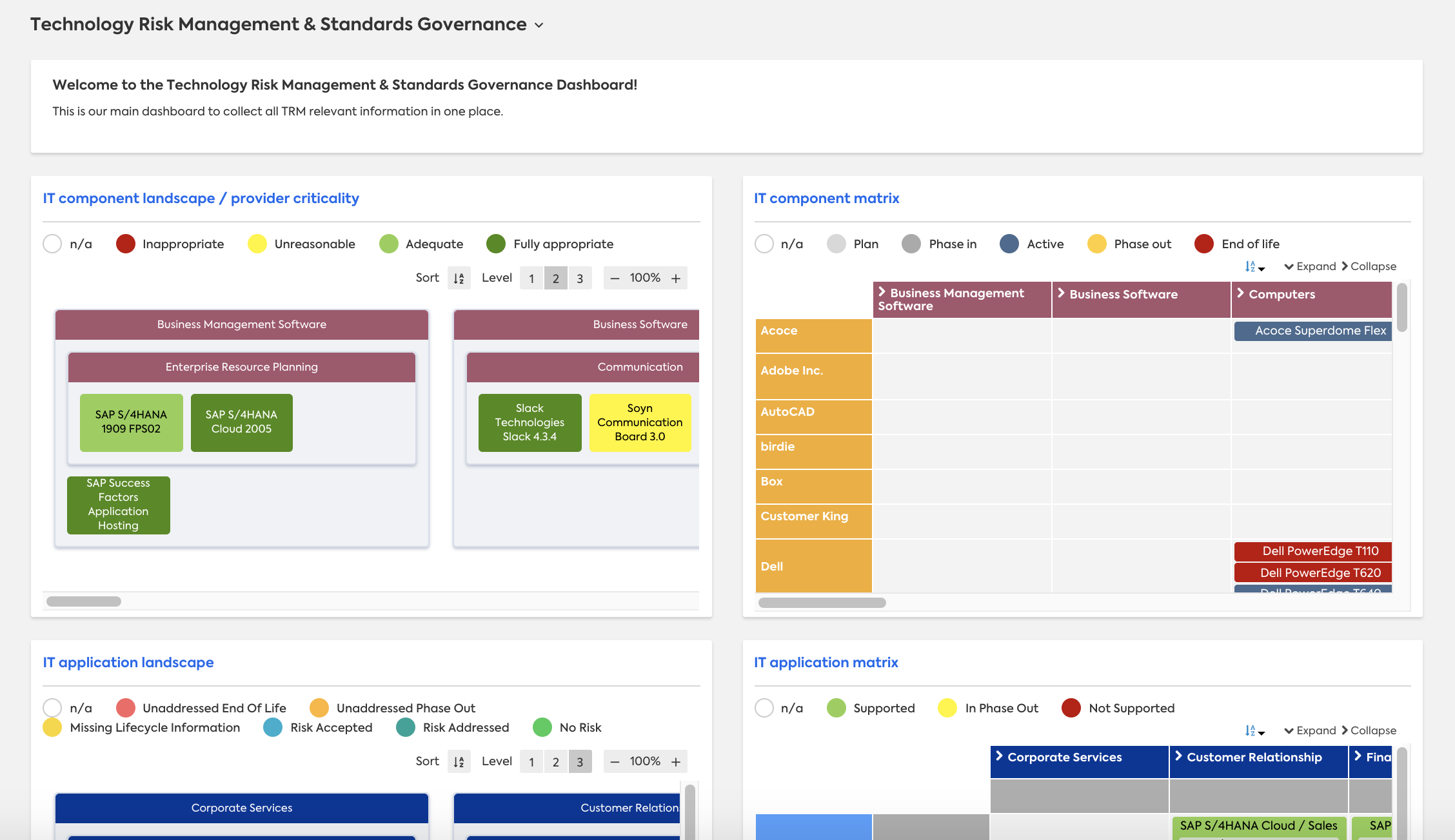
Example: Cloud Transformation
- Fact Sheet chart on Applications cloud transformation
- Fact Sheet chart on on-premise Applications, regarding the TIME model
- Reports Application Landscape with cost view
- Report on cloud migration project cost
- Report on current architecture 2020 versus target architecture in 2023
Requirements
In this example the Fact Sheet chart is making use of the Tag Group “TIME Model” with 4 Tags (Tolerate, Invest, Migrate, Eliminate) and the Tag Group “Cloud Transformation” with 4 Tags (On-Premise, Public Cloud, Hybrid Cloud, Private Cloud).
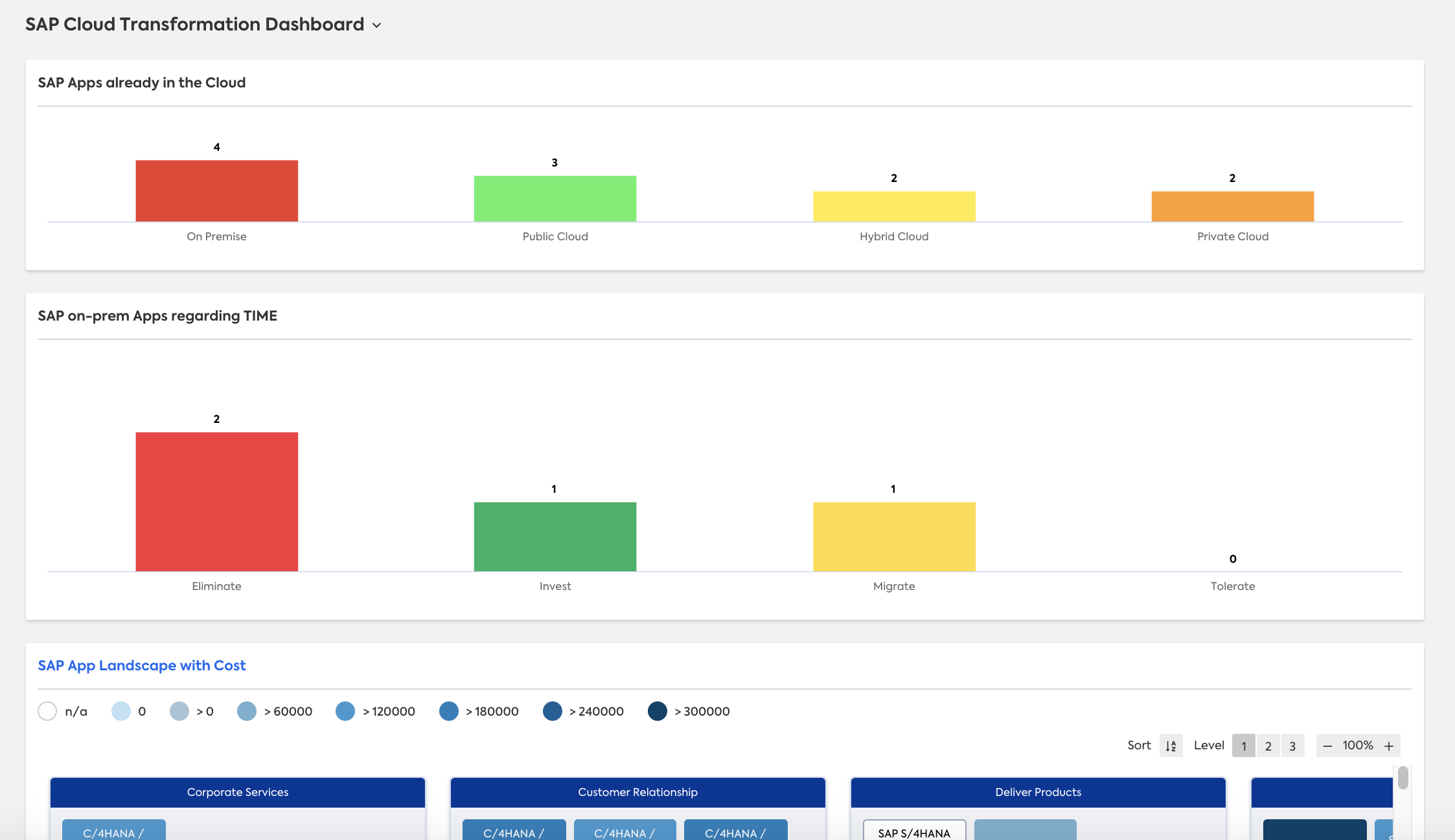
Example: KPIs for EA Status
- Fact Sheet chart on Applications with components reuse by Tag Group
- Fact Sheet chart on Projects reviewed by internal governance
- Fact Sheet chart on Project Landscape by Tag Group of projects strategic classification
- You might also want to include Metrics if applicable to show your KPIs development over time
Requirements
In this example the Fact Sheet chart is making use of the Tag Group "Components Reuse", Tag Group "Reviewed", Tag Group "Project Classification".
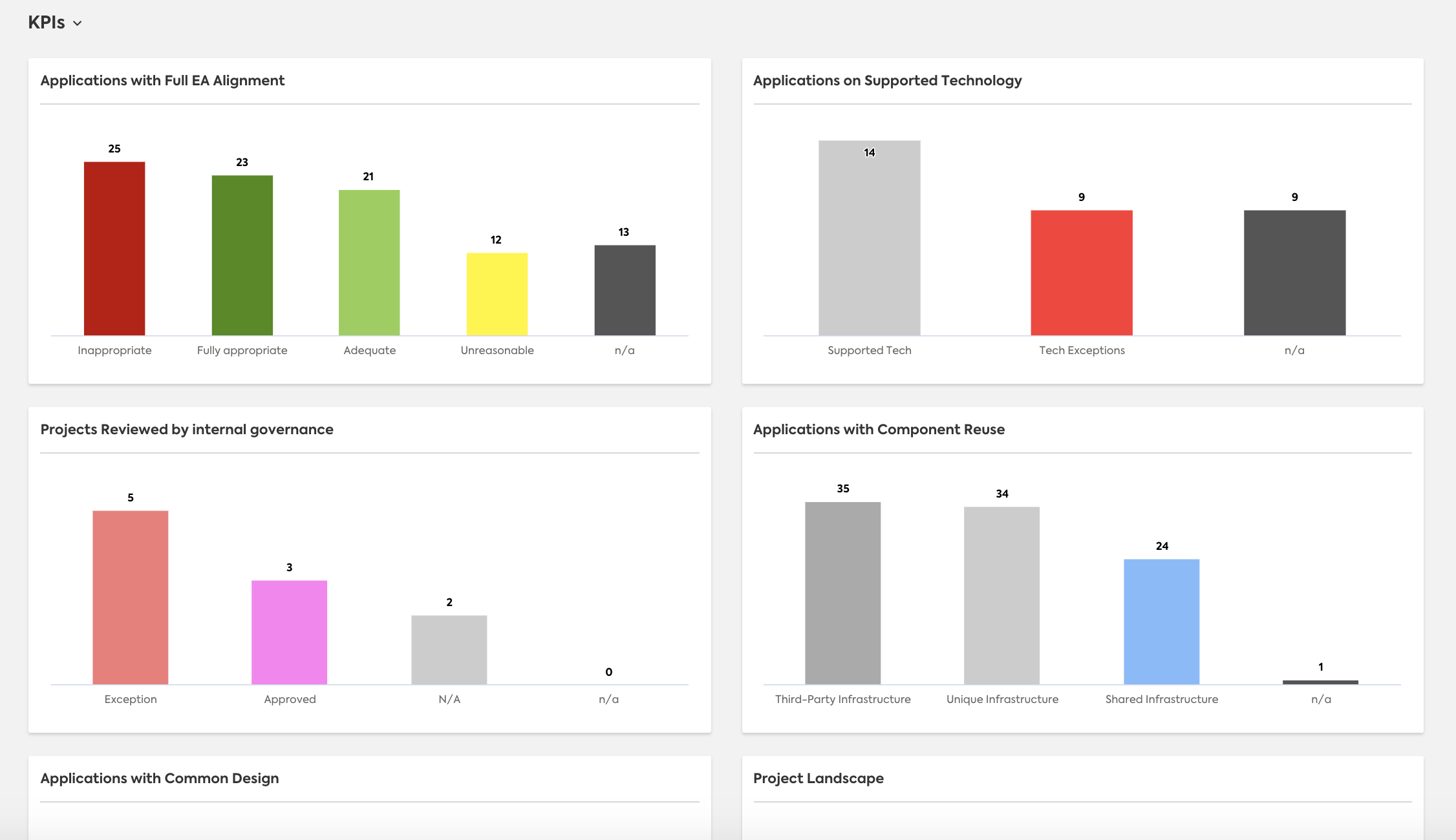
Deliverables
Important features:
- Welcome message to give introduction to companies strategy and deliverables deriving from that
- Find reports and Fact Sheet charts that show the status of pursuing your companies strategy
- e.g. a Cloud Migration Strategy
- You might also want to include Metrics if applicable to show strategies development over time
Example: Cloud Migration Strategy
- Application Landscape report with view on Cloud Migration Strategy
- Report on cost per Business Capability
- Fact Sheet chart on Tag Group "Cloud Migration Strategies"
Requirements
In this example the Fact Sheet chart is making use of the Tag Group "Cloud Migration Strategies" with 4 Tags (Repurchase, Replatform, Retain, Retire).
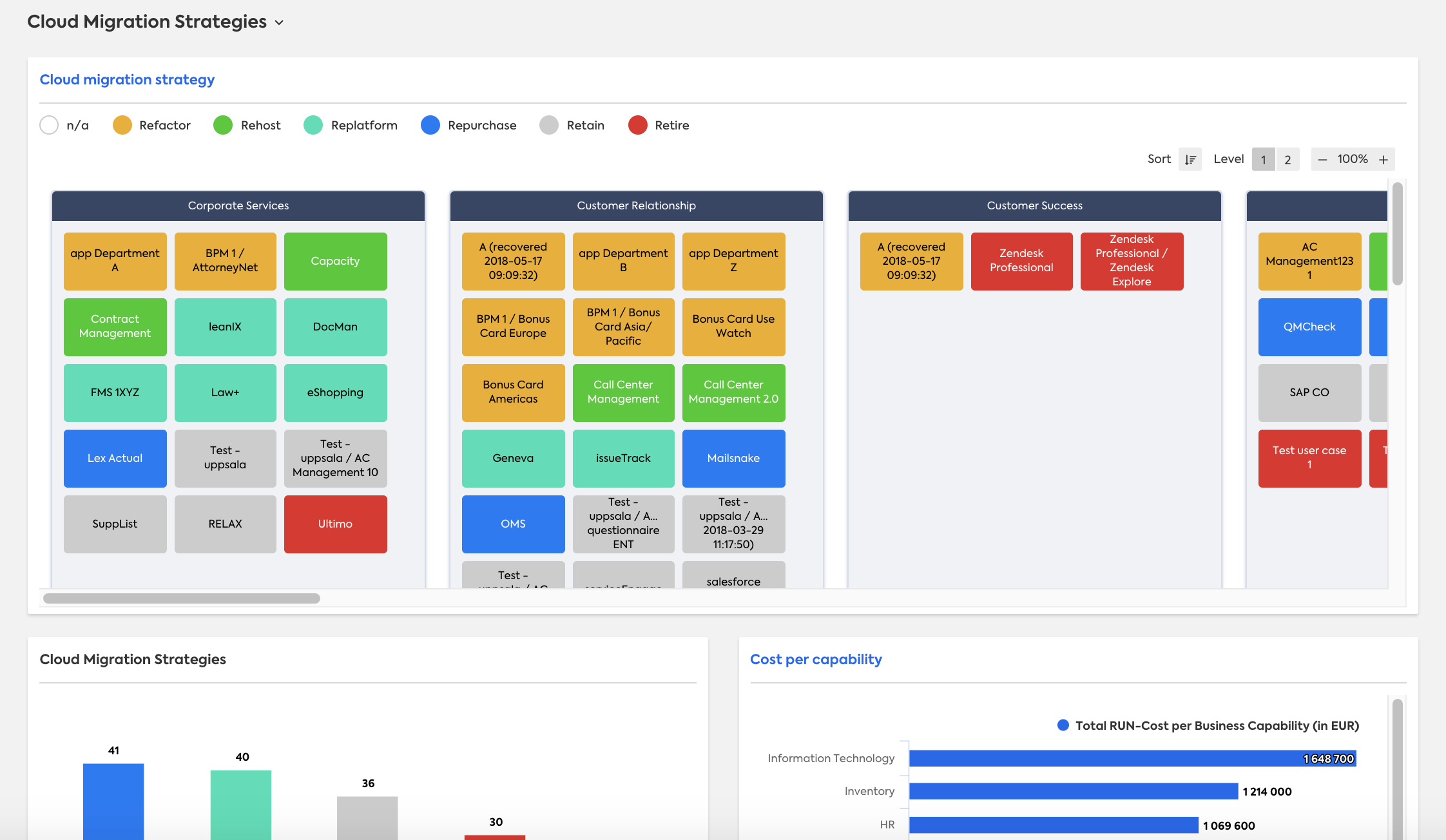
Updated 7 months ago
